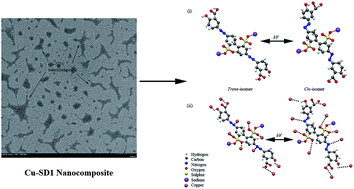Sulfuric disazo dye stabilized copper nanoparticle composite mixture: synthesis and characterization†
Abstract
A copper nanoparticle–sulfuric disazo dye (Cu–SD1) composite was synthesized using the sol–gel method. Cu–SD1 nanocomposite formation was monitored by ultraviolet-visible spectroscopy (UV-vis). The acquired experimental results suggested that 8 h of reaction is needed for the synthesis Cu0 nanoparticles. Transmission electron microcopy (TEM) and atomic force microscopy (AFM) were employed to elucidate the morphology of the Cu–SD1 nanocomposite. It was found that the diameter of particle sizes were in the range of 2–4 nm. The interaction of SD1 with copper was confirmed by Fourier transform infrared spectroscopy (FTIR). The peak shift of O–H and C–OH functional groups indicated the interaction between SD1 and copper nanoparticles. Moreover, the azo group (N![[double bond, length as m-dash]](https://www.rsc.org/images/entities/char_e001.gif) N) peaks were suppressed after the formation of the nanocomposite, suggesting that a strong linkage was formed between the functional groups and the copper nanoparticles. The surface composition and chemical states of the as-synthesized copper nanoparticles were elucidated by X-ray photoelectron spectroscopy (XPS). In addition, photo-switching of the composites was elucidated in the solution state. It was found that the Cu–SD1 nanocomposite has a faster switching response compared to the parent, SD1, in a solution.
N) peaks were suppressed after the formation of the nanocomposite, suggesting that a strong linkage was formed between the functional groups and the copper nanoparticles. The surface composition and chemical states of the as-synthesized copper nanoparticles were elucidated by X-ray photoelectron spectroscopy (XPS). In addition, photo-switching of the composites was elucidated in the solution state. It was found that the Cu–SD1 nanocomposite has a faster switching response compared to the parent, SD1, in a solution.


 Please wait while we load your content...
Please wait while we load your content...